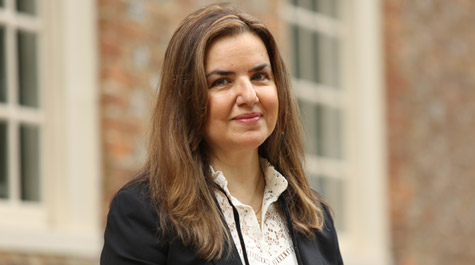Get to know Provost Peggy Agouris
Peggy Agouris became William & Mary’s sixth provost on July 1, succeeding Michael Halleran. An award-winning scholar and researcher, and former dean of College of Science at George Mason University, Agouris also directed the Center for Earth Observing and Space Research. W&M News checked in with the Athens, Greece, native to get her thoughts on everything from first impressions to goals for the year. - Ed.
Tell us about your first six weeks. What are your initial impressions?
My first impressions of William & Mary and this community are very positive. I have felt the kind of warmth when people know they belong together. I hope to become part of this environment where people feel committed to and invested in the institution, are happy that others are joining and are willing to make them feel welcome. I couldn’t be happier about my decision to come here.
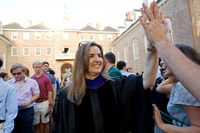 I’m looking forward to meeting more people; the individuals in this community make an institution. I intend to work very closely with students because, as the chief academic officer, I feel that my role is to make sure we graduate educated, compassionate, well-rounded citizens who can make a difference. It’s my responsibility to hear from them what they want from the institution and to educate them as to what we can offer, and also to advise them to take advantage of everything available to them at William & Mary.
I’m looking forward to meeting more people; the individuals in this community make an institution. I intend to work very closely with students because, as the chief academic officer, I feel that my role is to make sure we graduate educated, compassionate, well-rounded citizens who can make a difference. It’s my responsibility to hear from them what they want from the institution and to educate them as to what we can offer, and also to advise them to take advantage of everything available to them at William & Mary.
The provost doesn’t have an easy job. How do you plan to lead and tackle all that’s on your plate?
As chief academic officer, the provost needs to have a holistic view of what’s happening at the institution and in the world, of the challenges society is facing, and how we can take these challenges and embed our curriculum and labs with the capabilities to provide answers. In my career so far, I have never been confined within the bounds of a discipline. I was an engineer who became a scientist. I was trained as a classical musician and yet I became much more quantitative. Because of that, I felt my work needed to be enriched by other disciplines. And I did that; I included social sciences in my work. I’m from Greece, so classical knowledge and classical education — the humanities — were very important in the curriculum. Not only in K-12, but also in engineering school. I’ve always been exposed to a variety of perspectives.
Now this is my opportunity to put all of these vantages I’ve accumulated over the years to work. I’d like to make sure that people at William & Mary feel included, that their challenges are being understood and there are no silos to prevent them from working together.
You’ve lived, studied and worked around the world. Why move from George Mason, one of the youngest research universities, to the oldest?
I had 12 wonderful years at my previous institution, but William & Mary has a reputation that nobody can ignore. It’s the reputation of an influential, historic institution that has shaped the minds and futures of generations. I couldn’t think of a better environment than William & Mary, where sciences and the liberal arts are so critical. It wasn’t a difficult transition, because I was hoping to bring what I learned at a very young institution to enrich the perspective of an old institution that has always been an innovator.
That’s a great point, but there’s an inherent tension in a liberal arts and sciences university that is also a serious research university. What’s the best approach?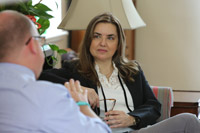
William & Mary’s strength has always been in providing a comprehensive liberal arts and sciences education — it’s not a stretch to see and do new things in those areas. The stretch is to make the world see and recognize us as that kind of institution, where these things come together beautifully. The world around us does not separate into STEM and non-STEM areas. Everybody is merging; we have innovations that have only developed because those boundaries have loosened. Today, there are no humanities without a digital awareness. My role, and the work ahead of me as provost, has been made easier because people understand and are eager to collaborate across disciplines to solve issues we’re facing. I view this as a privilege, to be in a world where we have strong humanities and social sciences that create a foundation for new developments.
Is there an example of what you mean?
William & Mary’s data initiative creates opportunities for humanities faculty and students working in areas not typically associated with quantitative learning. This is a perfect example of how digital literacy has brought a deeper understanding of the needs in non-quantitative areas. In my research, I had the best success when I incorporated qualitative elements into quantitative challenges. This type of broader approach leads everybody working in cutting-edge scientific areas to bigger discoveries.
Does this translate to the needs of the Commonwealth of Virginia and beyond?
William & Mary plays a tremendous role in meeting the needs of the Commonwealth. There are many organizations in the state needing an educated and capable workforce and the Commonwealth has promised thousands of graduates, particularly in computational areas. That can’t be accomplished without the participation and leadership of William & Mary. This is an opportunity to demonstrate how better prepared our graduates are because they have the holistic, well-rounded, humanities and sciences education William & Mary offers. We know what it takes to prepare for the challenges on the horizon, even those we don’t yet anticipate.
What qualities, values or actions do you believe make for an excellent provost? What’s key in this role?
First, a provost should not forget why they are in this role. A provost exists because people want to learn and want to really be members of an institution.
A provost needs to be open-minded, because the world around us is changing very rapidly. So things you think you know might not be true.
The provost role requires compassion and an understanding that everybody comes with different stories. You have first-generation college students alongside students who have been members of the William & Mary community for generations. What they all bring to the table is equally valuable.
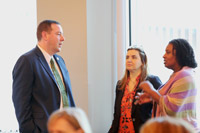 You have to be up to speed with academic advancements, on the education and research sides equally. Of particular importance right now is understanding advancements in educational delivery so that William & Mary can take advantage of technological developments to serve those who want to be members of this academic community.
You have to be up to speed with academic advancements, on the education and research sides equally. Of particular importance right now is understanding advancements in educational delivery so that William & Mary can take advantage of technological developments to serve those who want to be members of this academic community.
You also have to be able to put yourself in other people’s shoes and take a view outside your own.
So empathy?
Not just empathy; it’s more about thinking from the other’s perspective. I have been a faculty member, an international graduate student, a faculty senator and a department chair, and I don’t want to forget what I wanted the other side to do to improve my job and environment. I don’t want to forget the things that frustrated me or that I appreciated as chair. A good provost should be able to synthesize all of their experiences and adjust to the culture and the personality of the institution. Because what happened to me as an international student at Ohio State might not be equally relevant at William & Mary.
You’ve said that transparency, engagement and wellness are three areas of priority for you. Can you explain that in greater detail?
These three areas are connected. Transparency helps make hard decisions and hard actions less trying by explaining to people the necessity of those decisions.
Transparency also shouldn’t be limited to negative things. It makes everybody more connected when they know what is happening, why it is happening and their roles. That brings me to engagement. Faculty primarily, but also students and staff members, will never be engaged if they do not become part of the bigger vision, if they don’t know what is happening. Transparency gives rise to engagement by providing opportunities to participate in decision-making. Even if we do not agree, it is important to understand and consider the reasons why, especially when the goal is to have a decision that is accepted by many people of differing opinions.
Which is pivotal in shared governance.
Absolutely, and I believe in shared governance. I believe you cannot have engaged faculty and other constituents if they do not participate in figuring out how to move forward. We want members of this community to be involved as we consider how to do things better and more efficiently and how to thrive in our jobs without infinite resources.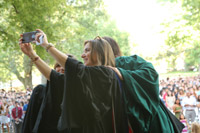
As a provost, wellness begins with listening. It’s also important to have processes in place that reward people so they know their work matters. The recognition is an important component, because we cannot always offer financial rewards. One thing that we did in the College of Science at Mason was to use the method of “Appreciative Inquiry,” which enabled us to identify what had been working well in our college, analyze the reasons why it had been working well and plan to do more of it in the future.
Nothing can move forward without establishing a foundation based on transparency, engagement and wellness. You need support from the people who are going to be in the trenches, and who are going to make it happen. You can’t engage them or expect enthusiasm from them if they don’t feel well, if they don’t feel connected to the institution, if they don’t feel heard, or if they don’t know what’s happening. That’s why I feel these three go hand-in-hand and connect to the success of academic initiatives.
As we enter the last year of the For the Bold campaign, how does the provost’s office participate?
The provost supports the fundraising initiatives of the institution by bringing to the table the reasons why the “asks” are so important. The provost needs to ensure that people understand the data, the success stories, the impact that participation makes to William & Mary and in students’ lives. I had significant fundraising responsibilities as dean of the College of Science at George Mason, and was focused in the sciences and linking specific discoveries to opportunities for impact. The provost’s role is more holistic by working across the entire university while also inspiring and motivating our community to ensure an excellent William & Mary education is offered to future generations.
Explain your role in the upcoming strategic planning process.
I’m co-chairing the Strategic Planning Steering Committee with Jeremy Martin, the president’s chief of staff, and I really see my role as a facilitator. I am part of the team that will collect what we’ve heard and maintain the focus of the process, and the depth of engagement that the process requires. It’s critical that we remain deep and focused in strategic planning. I’ll also work following up with the next steps. This is important because the plan isn’t simply carved on a wall and abandoned. It’s a living document, and a guide that moves us forward as an institution. The plan should become a mandate from the entire community to help chart our path forward. There will be many participants and many leaders in this process, but I want to make sure that at the end of the day, the academic heart of the institution is preserved and shown a direction to be stronger.
As you’re getting to know the campus, are you hearing about diversity and inclusion issues?
Diversity and inclusion was a critical component of the Board of Visitors’ and the administration’s leadership searches. William & Mary has accomplished much already, but there is more work to be done in this area. I support doing all that we can to increase diversity and to make sure that all who come here are welcome here, and that includes faculty diversity. There are identified tactics: training is one, incentivizing is another, spreading the word about open positions is a third. Committees must include role models who can help represent William & Mary as the inclusive campus it strives to be. We also need to make sure that people can prosper and stay at William & Mary. In higher education right now, recruitment is one thing, but retention is even more challenging. We need to do all of the above, and with energy and enthusiasm. Thankfully, I see that enthusiasm and support for sustained energy at William & Mary.
You’re originally from Athens. How has your experience as an immigrant shaped you?
I was fortunate because Greece is not that different than the United States. I never felt I was a foreigner; because I was a student, I became part of something bigger. Of course, it makes me sensitive to what others are going through because I can imagine how different my life would have been if I didn’t have the support of my institution, friends and families that opened their doors to me to welcome me. I came to the U.S. over Christmas at Ohio State. There were volunteers who invited foreign students to their homes because we were alone and didn’t have our families with us. I don’t even know the names of the people. But we went to their homes and they had presents for us, little presents. These people were just volunteers; there was nothing in it for them. This is the United States that made me decide if I’m not going to be in Greece, this the place I want to be. I felt like a member of this country, a citizen of this country, even when I was not.
What would you like the W&M community to know about you?
Family means everything to me. It’s important to maintain my relationship with my mother, sister and my extended family in Greece, so I try to go once a year. There are three summers since I left that I haven’t visited: when I was finishing my Ph.D., when I had my daughter, and this year.
Because I am like this, I believe it makes me a better leader because I understand that in everybody’s life, they have other things they care about in addition to their professional lives. That makes the work environment more productive, because it’s more human.
 Skip to main content
Skip to main content

